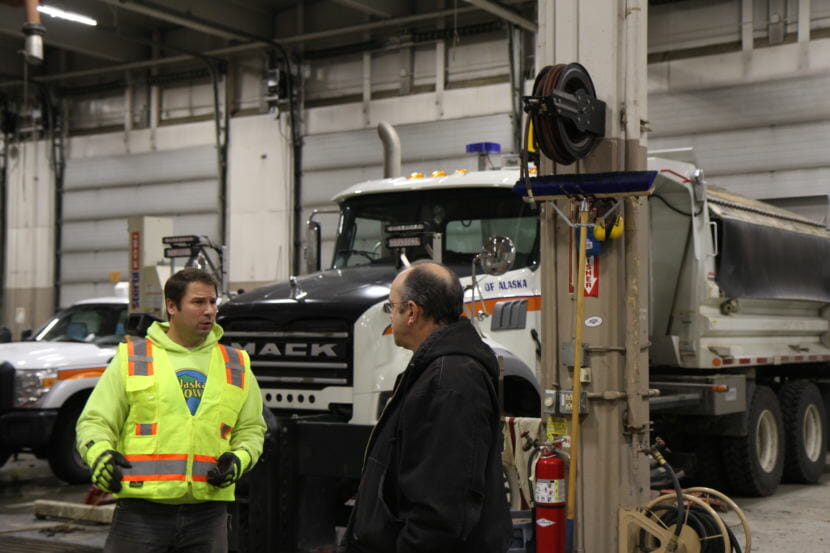
Unpredictable weather events can make a daily commute a real headache. Unfortunately, that’s becoming more common in Alaska as the climate warms.
It’s something the state’s Department of Transportation is trying to adapt to.
Brad Davis often starts his days at the Anchorage Department of Transportation garage at the crack of dawn. He’s living every 4-year-olds’ fantasy, getting to sit behind the steering wheel of a big truck.
“It is fun to drive. There’s a lot going on,” Davis said.
Inside, there’s an intimidating array of buttons, switches and knobs. One deploys a watery solution on the road called salt brine; it’s a cure for slippery pavement.
It’s is a relatively new tool in the toolkit for DOT in Anchorage. The Department has been using it for about three years. Before, they relied on a mixture of sand.
To assume this is a simple operation wound be wrong. The trucks and some roads are outfitted with a sophisticated network of sensors that can detect the temperature of the asphalt. This tells drivers the ideal time to dispense the salt brine.
“These guys can be always be busy depending on a storm event,”said Tom Grman, the superintendent of the Department of Transportation in Anchorage.
He started at DOT more than a decade ago and says this refined strategy to combat ice wasn’t around then.
“I can recall a time where we would have maybe one good freezing rain event a winter,” Grman said. “And then several winters ago, those were really prevalent.”
Now, Grman begins his day with a cup of coffee and an email notification of those temperature readings.
Meadow Bailey is a DOT spokesperson, and she said the Department has been forced to change the way it maintains its roads. Climate change has made it harder and more expensive to keep up.
There’s the freezing rain, of course. But there have been other issues, like damage to roads built on thawing permafrost and events that the department couldn’t have anticipated. In 2015, the Dalton Highway flooded, due to an extreme weather event. That limited access to the North Slope for weeks.
“Totally unique scenario no one ever heard of or thought of or could plan for,” Bailey said.
Keep in mind, this is all happening at a time when the state’s Department of Transportation has seen drastic budget cuts. For the past two years, the funding has remained flat.
Dan Schacher, the superintendent in Fairbanks, recalls a time when his department spent $750,000 more than normal.
“We had five consecutive months during the winter that we had measurable rain in Fairbanks, which is unheard of,” Schacher said. “So it’s continuing to become more and more of regular occurrence for us, and it’s something that we’re changing our methods to respond to.”
The Fairbanks DOT was the pilot project for the salt brine trucks, which Anchorage has now adopted. It’s part of a list of efficiencies the department has incorporated, including the high-tech temperature gauges.
Schacher admits the brine solution wasn’t popular initially with some drivers who were worried about it corroding their cars. But it’s a common treatment in the Lower 48. Alaska commuters can’t count on the winters of the past anymore.
“I think looking back it’s been good for us to go through some of the difficulties we’ve had because it made us reexamine some of our processes for the past 20 or 30 years,” Schacher said.
As for this winter, climatologists expect warm, wet conditions which can refreeze into ice.
The Department of Transportation will likely stay busy.